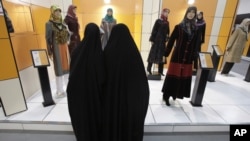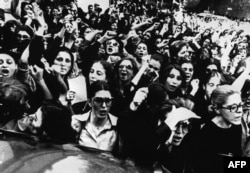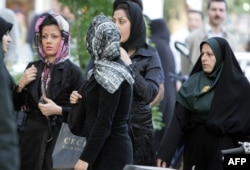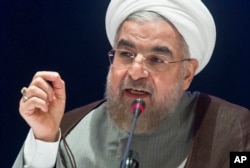Iran’s parliament last week approved a bill that would allow paramilitary forces to return to public streets and verbally enforce strict Islamic dress codes. Meanwhile, hardliners are reportedly pushing legislation that would support and protect citizen vigilantes who also want to help enforce the hijab. This comes in the wake of a string of acid attacks on women in Isfahan for not dressing properly.
President Hassan Rouhani repeatedly pledged to promote women’s rights and relax tough dress codes during his campaign and since was elected. But how committed is he — and will he deliver?
Nasrin Afzali doesn’t think so. A feminist activist now living in Canada, she once wrote for Zanan, a leading feminist magazine Iran shut down in 2007. She also received a suspended sentence of ten lashes and six months in jail for taking part in protests against gender discrimination. She sees recent events as part of a continuum that began with the Islamic revolution.
“It’s just a part of the same misogynist policy that has been going on for the last 35 years,” she said. “Another link in the chain of the Islamic Republic’s gender ideology.”
And she points out that the Isfahan acid attacks last month are not the first in recent times.
Hijab as symbol
Islamic tradition requires women to dress modestly, but how they do so varies from country to country. The hijab can include anything from a simple head covering to the chador, a full black cloak that encircles the entire head and body.
In 1936, Reza Shah Pahlavi banned traditional Islamic dress in Iran and imposed European clothing as part of an effort to modernize and secularize along Western lines — and sideline religious leaders.
The 1979 revolution came as a reaction to the repressive policies of the Shah and a rejection of the U.S., which had supported him. Many women protesters donned the hijab in a gesture of defiance as well as support of Ayatollah Khomeini, who preached a return to traditional Islamic law.
But shortly after he took power, Khomeini made the hijab compulsory and imposed tough penalties for violators. Under Mohammed Khatami, elected in 1997, women fared a little better.
“During the first years of the Khatemi era,” Afzali recalled, “we thought that all the black days were finished and that we would never see the moral police in the streets. I joined the first feminist website, and we wrote about women’s issues, and for the first time after the Revolution, NGOs were created, dealing with women and other social issues.”
Things changed under Ahmadinejad, elected in 2005, who worked to curb the women’s movement. His government shut down Zanan and allowed morality police to harass — sometimes brutally — and arrest women for improper hijab.
In the run-up to his 2013 election, Iran’s current president, Hassan Rouhani, promised to end the oppression of women and stop gender-based violence. He has repeatedly spoken out against the enforcement of tough Islamic dress codes by so-called morality police.
"Women must enjoy equal opportunity, equal protection and equal social rights," he said in comments that were broadcast live on television. In November, 2013, he banned the morality police from arresting women.
“Modesty is beyond wearing the hijab,” he said at the time. “The way the vigilantes interpret the question of modesty antagonizes our society and has negative results which is contrary to the teaching of Islam and is unconstitutional.”
Rouhani and women
That kind of rhetoric seemed to indicate Rouhani is committed to improving the lot of Iran’s women. But some analysts say that’s too simplistic a reading.
“Rouhani is a statist,” said Iranian analyst Steven Ditto. “He believes in the absolute authority of Khamenei as [Supreme Leader]. He is deeply committed to the ideals of the Islamic Revolution.”
What makes Rouhani different — and what gives him the reputation of being a reformist — is his belief that small-scale reforms can actually strengthen Iran politically.
“Rouhani deeply believes that through tweaking the status quo in terms of minority rights, education, and women's rights — along with easing economic pressure on Iran through nuclear negotiations — [he can] breathe fresh air into how the Iranian "system" is viewed domestically, by ordinary Iranians,” Ditto said.
“People will have pride to live in an Islamic country that combines an Islamic and Iranian identity.”
And this pride will lead to development, medical and scientific advances, he said, and enable Iran to meet long-term foreign policy goals.
It is in this context, said Ditto, that we must view Rouhani’s promises to women.
“There is no doubt Rouhani is committed to women's rights. But, does he care about women in and of themselves? Does he care about reform as an end unto itself? No. Rather, he views them as necessary for the ends of the state,” Ditto said.
Hardliners fight back
Last month, an unknown number of men on motorcycles threw acid at women they deemed were improperly dressed. Details are fuzzy, in part because of a crackdown on media coverage of the attacks. As many as two dozen women may have been targeted.
The attacks followed an earlier announcement by the radical Islamist group Ansar-e-Hezbollah (not to be confused with Hezbollah in Lebanon), which has a history of attacking individuals and institutions it deems as “un-Islamic.” On September 14, the group announced it would shortly dispatch thousands of male and female vigilantes into the streets to enforce proper dress codes.
“The attacks were very organized,” Afzali said. “The assailants were guarded by others driving cars behind them. And a few days before the attack, some women say they were sent text message in warning .”
She blames government conservatives and religious leaders for encouraging the violence.
“For one or two years, all of the Friday prayers have been focused on the hijab,” Afzali said. They [Friday prayer leaders] were very clear. They said the verbal enforcement of the hijab is no longer enough, and people should use physical force, even ‘shed some blood.’”
Isfahan’s Friday prayer leader called the acid attacks “reprehensible.”
In Iran, acid throwing is a capital offense. But hardliners in parliament have been looking for ways to protect vigilantes trying to enforce the hijab. Pending legislation to “promote virtue and prevent vice” would do just that.
“It’s a very general law that essentially codifies something that is already in Iran’s constitution,” said Human Rights Watch Iran researcher Faraz Sanei.
“There’s an article in Iran’s constitution that essentially says that the government must create a favorable environment for the growth of moral virtues based on faith and piety and the struggle against all forms of vice and corruption," Sanei said. "The people in parliament who introduced this bill say they are simply implementing and codifying what’s law already."
Parliament has already approved portions of the bill, but it’s still a long way from law.
“It still has to be vetted by the Guardian Council to ensure that it is in compliance with Sharia law, and then of course after that, it has to be signed by the president and published in the country’s official journal,” Sanei said.
If the bill passes, Sanei worries, it could open the door to more attacks.
Rouhani has harshly criticized the bill and promised harsh punishment for the acid attackers. At least ten suspects were arrested in October — and later released.
But Iran’s women, in the meantime, are dressing with a little more care.









